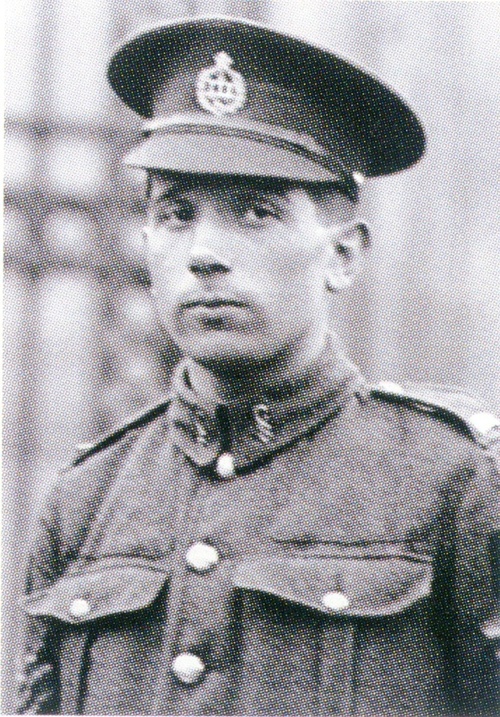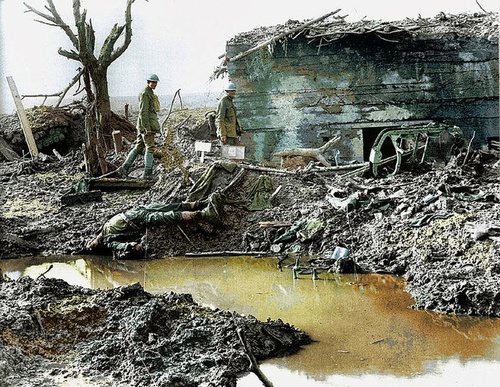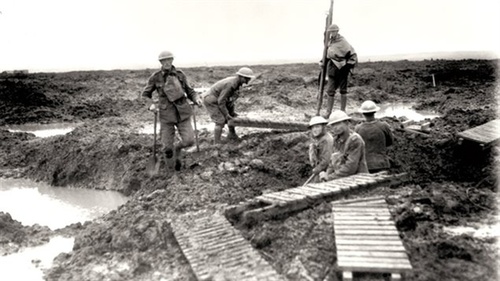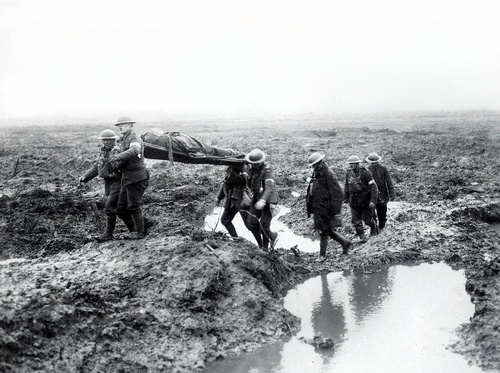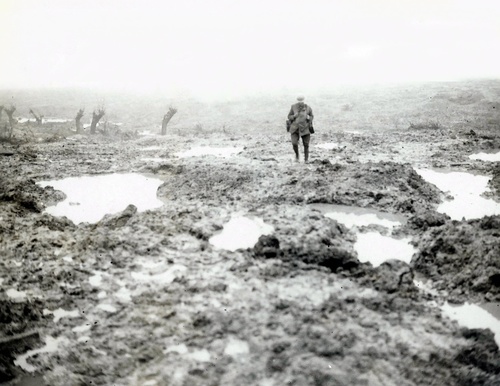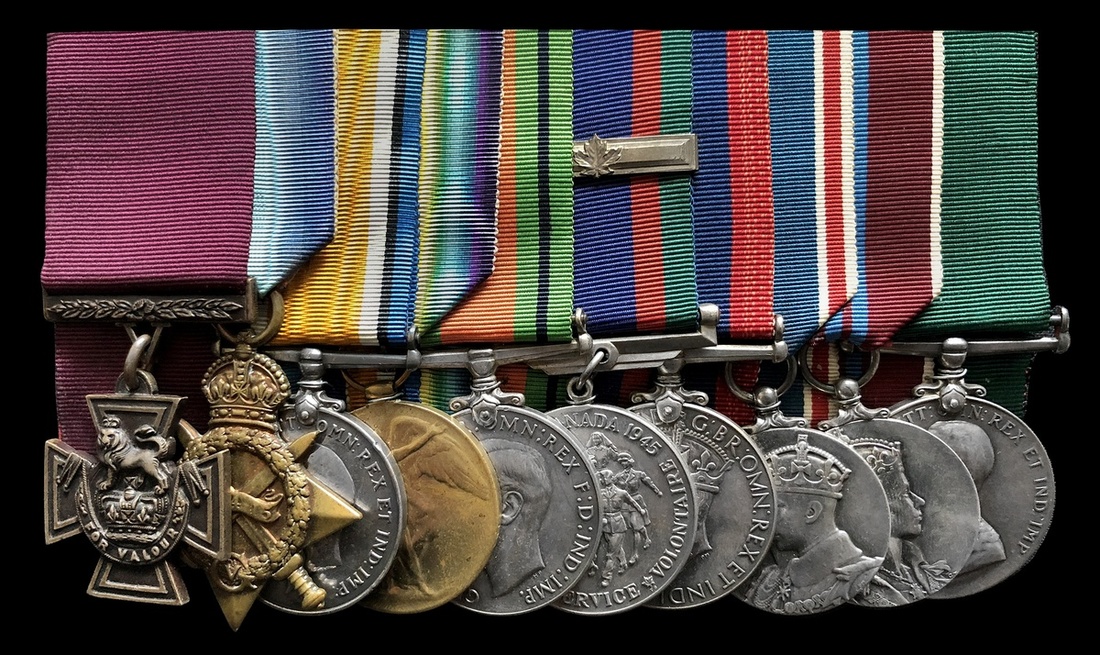Auction: 17003 - Orders, Decorations and Medals
Lot: 724
(x) IMPORTANT NOTICE
Please note that the Victoria Cross group of medals awarded to Corporal C. Barron, 3rd Canadian Infantry (1st Central Ontario Regiment), will be sold in Canadian dollars. The purchase price will be subject to a 20% buyer's premium, in addition to local taxes if purchased by a Canadian citizen.
The medals are held in Canada and will be available for viewing in Toronto by prior appointment. Please contact Tim Stewart at [email protected]
If purchased by a bidder from outside Canada, a cultural property export permit will be required to take the medals out of the country; this does not prevent said party from keeping the medals in Canada.
The sale is subject to our usual payment terms but in the event of an export permit being required, Spink will undertake the submission process on behalf of the purchaser. In that instance payment will not be requested until the export permit has been granted.
THE CANADIANS AT PASSCHENDAELE
OCTOBER-NOVEMBER 1917
Until after the implementation of the Military Service Act following its passage through the Canadian parliament on 29 August 1917, all Canadians fighting in the First World War had been volunteers and most were serving as soldiers in France and Flanders. By the end of the war, in that theatre alone, more than fifty-three thousand Canadians had given their lives for King and Empire. Since Canada's conscripts did not arrive in France until 1918, most of its war dead in that theatre had volunteered to be there. As Lyn Macdonald has written, a significant proportion of the Canadians on the Western Front were, 'very recent Canadians…many of them had emigrated in the years preceding the war'. One among them was Corporal Colin Barron, whose Victoria Cross is offered here: born in Banffshire in Scotland in 1893, he had emigrated to Canada in 1910 and seven years later was serving in the 3rd Battalion of the Canadian Expeditionary Force (C.E.F.).
For the C.E.F., 1917 was a very significant year. Mid-way between the triumph at Vimy Ridge in April 1917 and that at Amiens in August 1918, the eventual victory of the Canadians at Passchendaele in November 1917 would always be marred by the horrendous number of casualties - just short of the sixteen thousand predicted by Lieutenant-General Sir Arthur Currie, K.C.M.G., commander of the Canadian Corps, before the battle began.
By 1917, however, the C.E.F. had matured and learned hard lessons from the battles of Second Ypres in 1915 and Mount Sorrel and the Somme in 1916. Those lessons, together with the C.E.F.'s inestimable advantage of remaining a formation with a distinctly national character, involved careful attention to training, tactical innovation, good leadership and careful planning. The volunteer nature of the Canadian Corps, together with the meritocratic background of its officers and the lack of a tradition of unthinking deference to authority - as was still present in, for example, the British army at the time - greatly assisted the extensive planning that preceded the attacks on the Passchendaele Ridge late in October 1917. The enemy remained in his usual advantageous position, entrenched on and behind the ridge and thus with open views of the battlefield, using observation balloons to direct artillery and massed machine-guns and pillboxes to delay and suppress all attempts to assault the ridge. It was clear that a plodding frontal assault, even if preceded by an artillery barrage, would not carry the objective and at the same time would result in extremely heavy casualties. It would, too, be plodding since the nature of the terrain that had to be crossed under fire, much of it waterlogged even by Flanders standards and pockmarked by shell-holes, militated against a speedy assault. It would, though, always be an infantry battle.
Hence the tactics the Canadians adopted and which - despite heavy casualties - eventually drove the Germans from the ridge. These were what came to be called 'fire and manoeuvre' and 'bite and hold': assaults by highly trained and motivated units against specific targets, rapidly reinforced and supported by well-directed artillery that not only suppressed the German front line but, equally importantly, pounded their support trenches, from which reinforcements could be expected to arrive. For such assaults, each unit tended to operate independently, within the structure of a cohesive battle plan: the objectives identified initially were the interconnected pillboxes and machine-gun posts which need to be gradually and methodically reduced in order to negate the Germans' domination of the battlefield.
It was in just such an assault that Corporal Barron won his Victoria Cross, the details of which action are related below in this catalogue entry. For such assaults, qualities such as personal initiative, the ability quickly to understand a situation and the training necessary, equally quickly, to take command, were essential: it was these tactics that had been taught and practised at length by the Canadians in advance of October 1917. It is significant that of the eight Victoria Crosses won by Canadians for the battle of Passchendaele, seven were awarded for acts of gallantry similar to that demonstrated by Barron: involving great personal initiative and valour, focussed aggression and leadership with a concentration on the gradual and attritional achievement of the main objective. This was a tactic long taught in the Prussian, and then German, army - where it was called Auftragstaktik - and it had greatly benefitted them in the early stages of the war. Its adoption by the Canadians, together with their indomitable bravery against great odds, in appalling conditions and despite heavy casualties, contributed significantly to the result of the battle of Passchendaele, to the huge part played in its result by Canadians and, eventually, to the Allied victory in 1918.
[INSERT QUOTES OVER IMAGES OF PASSCHENDAELE]
'Squire nagged and bullied till I went to fight
(Under Lord Derby's scheme). I died in hell -
(They called it Passchendaele); my wound was slight,
And I was hobbling back, and then a shell
Burst slick upon the duck-boards; so I fell
Into the bottomless mud, and lost the light.'
'Memorial Tablet', by Siegfried Sassoon, refers.
'We could not believe that we were expected to attack in such appalling conditions. I never prayed so hard in my life. I got down on my knees in the mud and prayed to God to bring me through.'
Private 'Pat' Burns, 46th Canadian Infantry, Passchendaele, November 1917.
'There was not a sign of life of any sort. Not a tree, save for a few dead stumps which looked strange in the moonlight. Not a bird, not even a rat or a blade of grass. Nature was as dead as those Canadians whose bodies remained where they had fallen the previous autumn. Death was written large everywhere.'
Private R. A. Colwell, a subsequent visitor to Passchendaele.
[QUOTE ABOVE LOT]
'Between our line and the Spur there lay a very formidable strong point indeed, the pill-box at Vine Cottage. Now the pill-box itself was a standing testimonial to the thoroughness of German defensive works, but, in addition to its 18-inch walls of reinforced concrete and its appropriate armament, no less than six machine-guns had been placed in positions commanding every approach to this chef-d'oeuvre. Our fellows had attempted the reduction of this minor fortress a week before Corporal Barron and his section of the 3rd Battalion took the matter in hand, and had gained no appreciable results beyond a somewhat depressing casualty list and a raised estimation of German defensive ingenuity. However, its capture was imperative, and a special plan of attack was arranged.
At zero-hour, Lieutenant Lord's platoon jumped off towards the south-east, intending to capture Vine Cottage and swing round northwards to the final objective. Advancing through the rain, our men got near the strong point and were met at once by heavy fire. Vine Cottage itself, though hardly justifying its name, was a pleasant building enough in its Belgian way, and it was not until the observer had approached it nearly that he could define German handiwork behind the crumbling bricks. The enemy, with simple cunning, had raised a concrete building within the broken walls, with such successful camouflage that our scouting aeroplanes had not reported it as a pill-box for some time, while the easy unconcern with which the building received a direct hit by an 18-pounder shell had caused our gunners anxiety to a degree.
As the Canadians drew near they extended and attacked the position from three sides. Their advance was slow over the sodden ground. It was impossible to win close enough to the building or gun positions to throw bombs with good effect. Time and again our fellows charged, but from every point machine-gun fire drove them back, and finally they were forced to take whatever cover they could find, while a fresh scheme of attack was planned. The going was very heavy, and the mud and constant rain made the condition of the wounded terrible beyond description.
Our men started to attack once more, and as they rose to their feet a diversion occurred to the front. Corporal Barron, a Lewis gunner, had worked round the flank with his weapon, and was knocking out the German crews one after the other with his well-directed fire. Completely exposed, he directed his gun undisturbed by the point-blank shooting of the enemy, until he had silenced two of the opposing batteries. Then without waiting for his comrades, he charged the remaining position with the bayonet, getting in among the gunners and killing four of them before the rest of his platoon could arrive.
The slackening of the heavy fire gave the Canadians a chance to get well forward and in a moment they were about the position. The guns Barron had been unable to reach kept up a heavy fire until our fellows were on top of them, when most of the crews surrendered, while others attempted to escape to the rear. But the Canadians had lost too many of their comrades to feel merciful, and they were infuriated at the general morale of men who would maintain murderous shooting until imminent danger pressed and then calmly sue for mercy. They took few prisoners. Corporal Barron, however, had not finished his good work. Turning the enemy's guns about, he opened upon the retreating Germans, catching the groups upon the hillside, and shooting them down with such good effect that hardly a man escaped.'
Creagh, Sir O'Moore, and Humphris, E.M., The Victoria Cross 1856-1920, refers.
The outstanding Great War Passchendaele V.C. group of ten awarded to Corporal C. Barron, 3rd Canadian Infantry (1st Central Ontario Regiment): one of his daughters later recalled that, 'As a young man, he was a bit of a devil. And he was a fighter, too. He could be quite fearsome when his temper was up.'
That 'temper' was ignited in spectacular fashion by the terrible casualties suffered by his comrades as they closed the formidable 'Vine Cottage' feature on Goudberg Spur near Passchendaele Ridge on 6 November 1917. Having taken out three enemy machine-gun posts with a Lewis gun, he proceeded to set about the survivors in no uncertain fashion: an eye-witness later stated that 'There was a wild melee in the confined space … with Barron using the bayonet and clubbed butt of an old rifle he had picked up, to terrible effect.'
Then, for good measure, he turned one of the captured machine-guns on the retreating Germans: in so doing he turned the tide of battle, a feat which thousands of artillery shells - and considerable loss of life - had hitherto failed to do
(i)
Victoria Cross (404017 Cpl. C. Barron, 3rd Bn. Can. R. (1st Cen. Ontario); 6 Nov. 1917)
(ii)
1914-15 Star (404017 Pte. C. Barron, 3/Can. Inf.)
(iii)
British War Medal 1914-20 (404017 Sjt. C. Barron, 3-Can. Inf.)
(iv)
Victory Medal 1914-19 (404017 Sjt. C. Barron, 3-Can. Inf.)
(v)
Defence Medal 1939-45, silver
(vi)
Canadian Voluntary Service Medal 1939-45, overseas clasp
(vii)
War Medal 1939-45, silver
(viii)
Coronation 1937
(ix)
Coronation 1953
(x)
Colonial Auxiliary Forces Long Service, G.V.R. (C.S.M. - W.O. Cl. 2 C. Barron, V.C., 48th Highrs. of C.), mounted court-style as worn, the Great War trio and the Long Service Medal polished, thus good fine, the remainder very fine or better (10)
V.C. London Gazette 11 January 1918:
'For conspicuous bravery when in attack his unit was held up by three machine-guns. Corporal Barron opened on them from a flank at point-blank range, rushed the enemy guns single-handed, killed four of the crew, and captured the remainder. He then, with remarkable initiative and skill, turned one of the captured guns on the retiring enemy, causing them severe casualties. The remarkable dash and determination displayed by this N.C.O. in rushing the guns produced far-reaching results, and enabled the advance to be continued.'
Colin Fraser Barron was born at Baldavie, Boyndie, Banffshire, Scotland, on 20 September 1893. His mother, Margaret 'Maggie' Barron, was a domestic servant and his father, William Cowie, was a soldier. They were not married. Colin was brought up by his maternal grandparents, Joseph and Mary Barron (née Reid).
Colin - and his brother Alexander - emigrated to Toronto, Canada in March 1910, where he found employment as a teamster. He also joined the 48th Highlanders, a militia unit, in May 1913.
He subsequently enlisted in the Canadian Overseas Expeditionary Force in Toronto in April 1915, when his medical report noted a healed break to his left shoulder bone. Drafted to the 35th Battalion, Canadian Infantry, and thence to the 23rd Reinforcement Battalion in England, he joined the 3rd Canadian Infantry (1st Central Ontario Regiment) in France in July 1915.
Present in the costly Somme operations of 1916, he advanced to Lance-Corporal in April 1917, at the time of the Vimy Ridge offensive. Having then been promoted to Corporal in July of the same year, he was, as described above, awarded the Victoria Cross for his remarkable courage at Passchendaele in November.
Victoria Cross
On the morning of 6 November 1917, amidst the mud and carnage that constituted the battlefield of Passchendaele Ridge, the distinguished war correspondent Philip Gibbs could only see one landmark 'through the smoke of gunfire and the wet mist', the ruins of a church, 'a black mass of slaughtered masonry'.
Of subsequent events, no better summary may be quoted than Stephen Snelling's account in V.C.s of the First World War: Passchendaele 1917:
'On the left, the Canadians of the 1st Division had the task of clearing the enemy strongpoints along the spurs feeding on to the main ridge north-west of Passchendaele. As always, the lines of attack were governed by the swamp. The entire divisional frontage was constricted into the 380-yard width of the Bellevue-Meetcheele spur, along which the 1st (Western Ontario) and 2nd (Eastern Ontario) Battalions were to advance in conjunction with a flank attack by the 3rd (Toronto) Battalion to the east astride the Goudberg spur. The latter operation was a continuation of the efforts made by the 5th Canadian Mounted Rifles to capture the Vine Cottage strongpoint. The ruined farmhouse sheltered one of the largest pillboxes in the sector, with walls reckoned to be 18 inches thick and machine-guns covering every conceivable approach. The defenders also had another ally - the mud. The rain and relentless shelling had created a glutinous barrier guaranteed to restrict any assault.
Conscious of the difficulties, Lt. Col. J. B. 'Bart' Rogers. D.S.O., M.C., drew up a plan which concentrated on dealing with Vine Cottage. His attacking force consisted of C and D Companies and two platoons from A Company, under the command of Major D. H. C. Mason D.S.O. The spearhead, led by Captain J. K. Crawford, comprised C Company and the elements of A Company, attacking on a three-platoon front with three platoons in close support. Lt. H. T. Lord's platoon was given the job of seizing Vine Cottage. At 6 a.m., the two most northerly platoons of Crawford's force slipped out of their shell-holes near Vanity House and crept as close to the barrage as they dared. An anxious ten-minute pause followed before the bombardment ranged on to their objective, and then they moved off. The swampy ground made it impossible to approach Vine Cottage due eastwards from the jumping-off line. Lord had no choice but to attack south-eastwards, maintaining shape and direction under trying conditions, before swinging left to reach the battalion's final objective facing due north. Hardly surprisingly, the attack did not run smoothly.
It was soon apparent that the barrage had made little impression. The defences consisted of two intact pillboxes, of which the largest was at Vine Cottage, and 'a multitude of two or three man "funk holes" dug into the side of deep shell-holes'. From these burst a withering fire which combined with the mud to delay both Crawford's and Lord's advance. Each machine-gun had to be assaulted in turn, leading to heavy losses. Retribution, however, was severe. Lt. Col. Rogers candidly reported:
'When our men got to within about 20 yards of them they ceased firing and the crews attempted to surrender but in the majority of cases they were given no quarter and the bayonet was used to good effect as our men were infuriated at the casualties which had been caused by them.'
Slowly, and at considerable loss, Lord's depleted platoon closed in on Vine Cottage and the outlying posts. A persistent drizzle was falling as they divided into smaller parties, hoping to confuse the defenders by rushing from three directions at once. But every time they were driven back before they could get within bombing range. As casualties mounted in proportion to the number of failures, it appeared as though Lord's attack would go much the same way as that of 5th C.M.R. on 30 October. That it did not do so was due to the resolution and initiative of Corporal Colin Barron, a Scots-Canadian member of D Company.
Barron, who was commanding one of the Battalion's Lewis gun sections, had grown frustrated by the repeated reverses. So he decided to show the way. Worming his way round the flank, lugging his weapon with him, he somehow managed to reach a position close by the strongpoint without being seen. Then, he opened fire at 'point-blank range' with devastating results. Two of Vine Cottage's three machine-gun crews were annihilated one after the other by his deadly fire. According to Rogers, they were put 'absolutely out of action'. The third gun, blocked from Barron's view, continued to fire, but even before the pillbox's startled garrison had time to react, their nemesis was among them, followed by the remnants of his platoon bent on revenge. According to one account: "There was a wild melee in the confined space … for a few moments, with Barron using the bayonet and clubbed butt of an old rifle he had picked up, with terrible effect.'
Four men fell to Barron and the remainder, according to his V.C. citation, were taken prisoner, although given Rogers's earlier comments this must be a matter for some conjecture. In his own account, he makes no mention of Corporal C. F. Barron prisoners, merely stating that 'at least a dozen of the enemy' were bayoneted in the final assault. Barron, meanwhile, rounded off his whirlwind attack by turning one of the captured machine-guns on to those members of the garrison who had escaped his frenzied charge.
Much behind time and greatly reduced in number, Lord's platoon had nevertheless accomplished their mission, and succeeded in linking up with Captain Crawford's force. Enemy machine-guns continued to play havoc along the Canadian lines of communications and, although reports of Vine Cottage's capture had been made shortly after 11 a.m., it was not until 12.30 p.m. that Battalion H.Q. received confirmation of their success … All told, Crawford's platoons had taken fifty-nine prisoners, including one officer, and captured five machine-guns, three of them taken by Corporal Barron at Vine Cottage. The price, as always, was a heavy one: 64 men, including 3 officers, dead, 154 wounded and 22 missing.'
Two months after his V.C. was gazetted, Barron returned to his native Scotland to receive a gold watch and 'a wallet of Treasury notes' from the Duke of Richmond and Gordon. They were presented to him at a special reception held at Whitehills.
He was subsequently employed as a Lewis Gun Instructor and promoted to the acting rank of Sergeant, prior to his return to Canada in April 1919. Discharged in Toronto at the end of the same month, he re-enlisted in the 48th Highlanders in November 1921 and rose to the rank of Company Sergeant-Major prior to his retirement in May 1931.
Between the Wars
In common with many veterans of the Great War, Barron suffered periods of unemployment in the 'Depression'. A glimpse of that misfortune is to be found in the pages of the Toronto Sun:
'At 5-foot-7, the Royal Canadian Mounted Police didn't think Barron was tall enough. There must have a been a few German soldiers rolling over in their graves in Flanders. Clearly Barron had the wits and courage, as the Victoria Cross attests, but he also had the experience, as he had worked for the Ontario Provincial Police for several years in Kitchener, Niagara Falls and Orangeville.'
For further details see:
http://www.torontosun.com/2016/11/05/brave-enough-to-win-victoria-cross-not-tall-enough-for-mounties
Militia and Provincial Police appointments aside, Barron ran his own transport business, working for the Ontario Department of Highways. He also worked as a guide at provincial government buildings and on the security staff of Don Jail.
The Second World War and beyond
When the Second World War broke out, 46-year-old Barron joined the Royal Regiment of Canada, successors to the Toronto Regiment. Described at the time as being 'still powerful and built for hand-to-hand fighting', he became the first Canadian holder of the V.C. - who was not a member of the Permanent Force - to be sent overseas. He was a member of the Canadian force that occupied Iceland and afterwards served as Provost Sergeant-Major at 1st Division H.Q. in England.
Back in Toronto at the war's end, he returned to his job as a security guard at Don Jail. He later joined the Canadian Corps of Commissionaires, for whom he worked at the public broadcaster CBC, Hester How School and Sunnybrook Hospital.
Barron died in Toronto on 15 August 1958, aged 64 years, and is buried in Veterans' Section 7, Grave 3562, Prospect Cemetery, Toronto.
His brother, Alexander, was killed in action at Hooge Crater in Belgium on 6 June 1916. He has no known grave and is commemorated on the Ypres (Menin Gate) Memorial.
Postscript
Today, 'Vine Cottage' is gone and there is a horse farm in its place in the picturesque countryside. It's on Paardebosstraat - which is Flemish for Horse Boss Street. It might just as well have been called 'Barron Street', but that honour was bestowed on him by the city of Toronto, which named a street after him in East York.
Barron was also the inspiration for Ray Francis's fictional work, A Round Trip to Hell (Lulu Press Inc., 2014).
Parallels to his Great War experiences are to be found in the war film Passchendaele (2008), the highest-budgeted Canadian-production of all time. The film had its premiere at the Toronto International Film Festival on 4 September 2008, when it also had the honour of opening the festival; it was released widely in Canada.
The film was written, co-produced and directed by Paul Gross. He also appeared in the lead role as a decorated Canadian soldier who fought at Passchendaele. Gross's inspiration for the story stemmed from the experiences of his maternal grandfather, Michael Joseph Dunne, who, in common with Barron, was onetime a member of the 23rd Reinforcement Battalion. They both had Scottish roots and were likely known to one another. More certain is the fact they shared in the mud and carnage that constituted the battlefield known as Passchendaele Ridge: one of them was awarded the V.C. and the other, to quote the film script, 'should have got the V.C.'
Reference sources:
Creagh, Sir O'Moore, and Humphris, E.M., The Victoria Cross 1856-1920(London, 1920).
Macdonald, L., They called it Passchendaele (London, 1979), pp. 212-230.
Nicholson, G.W.L., Canadian Expeditionary Force 1914-1919 (The Official History of the Canadian Army in the First World War) (Ottawa, 1962), pp. 298-339.
Oliver, D., 'The Canadians at Passchendaele' in Liddle, P. (ed.), Passchendaele in Perspective (London, 1997), pp. 255-271.
Snelling, Stephen, V.C.s of the First World War: Passchendaele 1917 (Sutton Publishing, 1998).
Steel, N. & Hart, P., Passchendaele: the Sacrificial Ground (London, 2000), pp. 284-301.
The recipient's official service record; 55pp. copied record included.
Subject to 5% tax on Hammer Price in addition to 20% VAT on Buyer’s Premium. For more information please view Terms and Conditions for Buyers.
Sold for
Can$350,000
Sale 17003 Notices
Please note that the Victoria Cross group of medals awarded to Corporal C. Barron, 3rd Canadian Infantry (1st Central Ontario Regiment), will be sold in Canadian dollars. The purchase price will be subject to a 20% buyer's premium, in addition to local taxes if purchased by a Canadian citizen.


